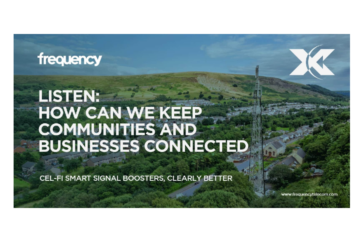Higher and more masts are being rolled out to level up rural areas with better connectivity and unlock tech innovation in the countryside.
15% of UK homes and businesses, particularly in rural areas, will be left with slow and expensive broadband for many years to come. However, one scheme, the Shared Rural Network may be able to provide a quicker solution to connectivity by delivering 4G coverage to 95% of the UK by 2026, enabling rural businesses and communities to thrive.
Under the new government proposal, higher and more masts will bring better coverage in the countryside by reducing build time and costs for new infrastructure while protecting rural areas by minimising any visual impact. The move will turbocharge the delivery of the £1 billion Shared Rural Network being built to eliminate 4G mobile ‘not spots’ in the countryside and will speed up the rollout of next-generation 5G networks.
A reduction of partial not-spots during the first phase of the Shared Rural Network (SRN) roll-out could see UK rural communities contribute an added £58.9m to UK GDP each year, with Scottish businesses and areas of the hospitality sector in line to enjoy the biggest gains.
High-speed mobile connectivity is a central part of modern life whether you live and work in a city centre or in the countryside. The ambition is to make sure everyone can benefit from fast services on the go – from those running small businesses to people shopping or booking travel online to speaking to friends and family. It will spur economic growth and close the digital divide across the country through better connectivity.
- Why Does The UK Require More And / Or Higher Masts?
- How Will They Increase Connectivity?
- What Is 5G And How Is It Better?
- Will This Improve In-Building Mobile Connectivity?
Why Does The UK Require More And / Or Higher Masts?
Before we answer that question, it is necessary to explain how mobile transmission and connectivity work.
The key to reliable mobile coverage is to provide an uninterrupted signal from the mobile network masts to a mobile device. Mobile signal is transmitted from mobile towers via radio frequencies (RFs). These RFs can be weakened or completely blocked by obstructions. The distance and obstructions between you and a mast will determine how good or poor your mobile connection will be.
The UK is under-mast’d. Ofcom has found that 7% of the UK’s landmass is not covered by any mobile operator and 30% does not receive voice and data services from all four operators.
People want fast and reliable mobile signal that reaches where they work and live. Masts and antennae are critical to providing that service. But they often arouse passionate opposition from residents objecting to their location, height, and look.
Most new masts will still need to be approved by local authorities and will have a say on where they are placed and their appearance. Robust conditions and limits will remain in place to make sure communities and stakeholders are properly consulted and the environment is protected.
Without masts, people in rural and remote areas will wait a long time before having good internet connectivity. With connectivity key to economic growth, it is imperative to provide rural areas with access to the same connection speeds and operator choices as urban counterparts.
How Will They Increase Connectivity?
Higher or new masts should improve the ‘not-spots’ in rural areas. These new or higher masts allow mobile signal to reach over the ‘clutter’ (buildings, trees, etc.) and improve the area covered massively. (Think of it as the radius of a circle – the area covered increases as the square of the radius.)
In truly rural areas, where there are not so many users, making a mast higher means you may not need to add new masts to cover areas not currently covered.
The government proposal will incentivise mobile firms to focus on improving existing masts over building new ones, with fewer new masts needed for rural communities to get a better signal now and to take full advantage of future 5G-connected technology. This includes innovations in remote healthcare, self-driving vehicles, and smart devices such as fridges, TVs and heating systems.

What Is 5G And How Is It Better?
5G is the next generations of wireless technology which will enable faster browsing and greater capacity, allowing thousands of devices in a small area to be connected at the same time.
Local authorities, farming, manufacturing, transport networks and public bodies are some of the sectors that are using or testing 5G. It could also bring major changes to healthcare. For example, by enabling technology that allows medical students to practise surgery in a connected, virtual reality environment that reflects a real-life experience – even enabling them to ‘feel’ the surgery they are training to deliver.
The connectivity offered by 5G also allows existing applications to be carried out faster and more reliably.
However, 5G is transmitted over a higher radio frequency which is more susceptible to obstructions and interruptions. Therefore the higher and more masts will enable 5G to be delivered to rural and remote areas.
Will This Improve In-Building Mobile Connectivity?
Many people struggle to get a poor mobile signal, particularly indoors. Since 85% of all mobile phone calls are made indoors, this can be particularly frustrating. The good news is that providing there is mobile signal somewhere in or just outside your home or building, a mobile signal booster will improve your indoor mobile coverage.
Mobile phone boosters or repeaters amplify signal between a mobile phone and a mobile network tower. It makes voice calls clearer, prevents dropped calls and provides a stable 3G/4G data connection with download speeds improving from 9.45Mb/sec to 30.2Mb/sec and uploads from 0.11Mb/sec to 6.19Mb/sec. It allows you to stream high-quality videos, browse the web, play games, send text messages, and so much more without needing a WiFi connection.
Construction materials, distance to cell tower and geography are the main causes for poor indoor mobile signal.
A mobile signal booster solution consists of three units: a reception antenna, a signal booster, and an internal rebroadcast antenna. Think of the latter as a mobile phone mast designed and configured to provide mobile signal inside a specific building only. The external antenna will collect the best mobile signal from outside and transmit it to a mobile signal booster unit which strengthens the signal and retransmits it internally.
On 12 April 2018, Ofcom passed the Wireless Telegraphy (Mobile Repeater) (Exemption) Regulations 2018 which permits the use of certain types of mobile phone boosters without the need for a licence.
Two categories of repeaters are covered by the licence-exempt regulation: static mobile phone repeaters for indoor use, and low-gain mobile phone repeaters for in-vehicle use. These repeaters must comply with the required technical standards and conditions of use.

Cel-Fi mobile signal boosters are a cost-effective and quick-to-install solution that can provide a stable and reliable mobile connection for voice and data on 3G/4G/5G. Cel-Fi products are the ONLY mobile signal boosters available on the market that are licence-exempt and fully comply with the regulatory requirements with Ofcom IR 2102 (UK) and ComReg S.I.No.283 of 2018 (Ireland).





